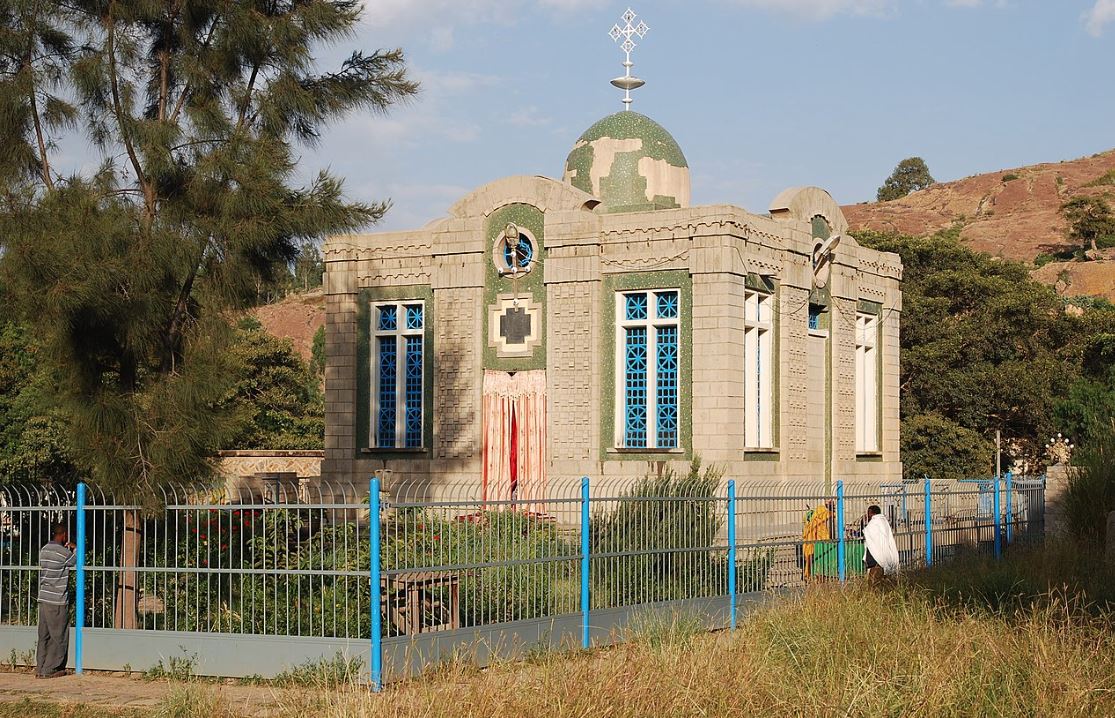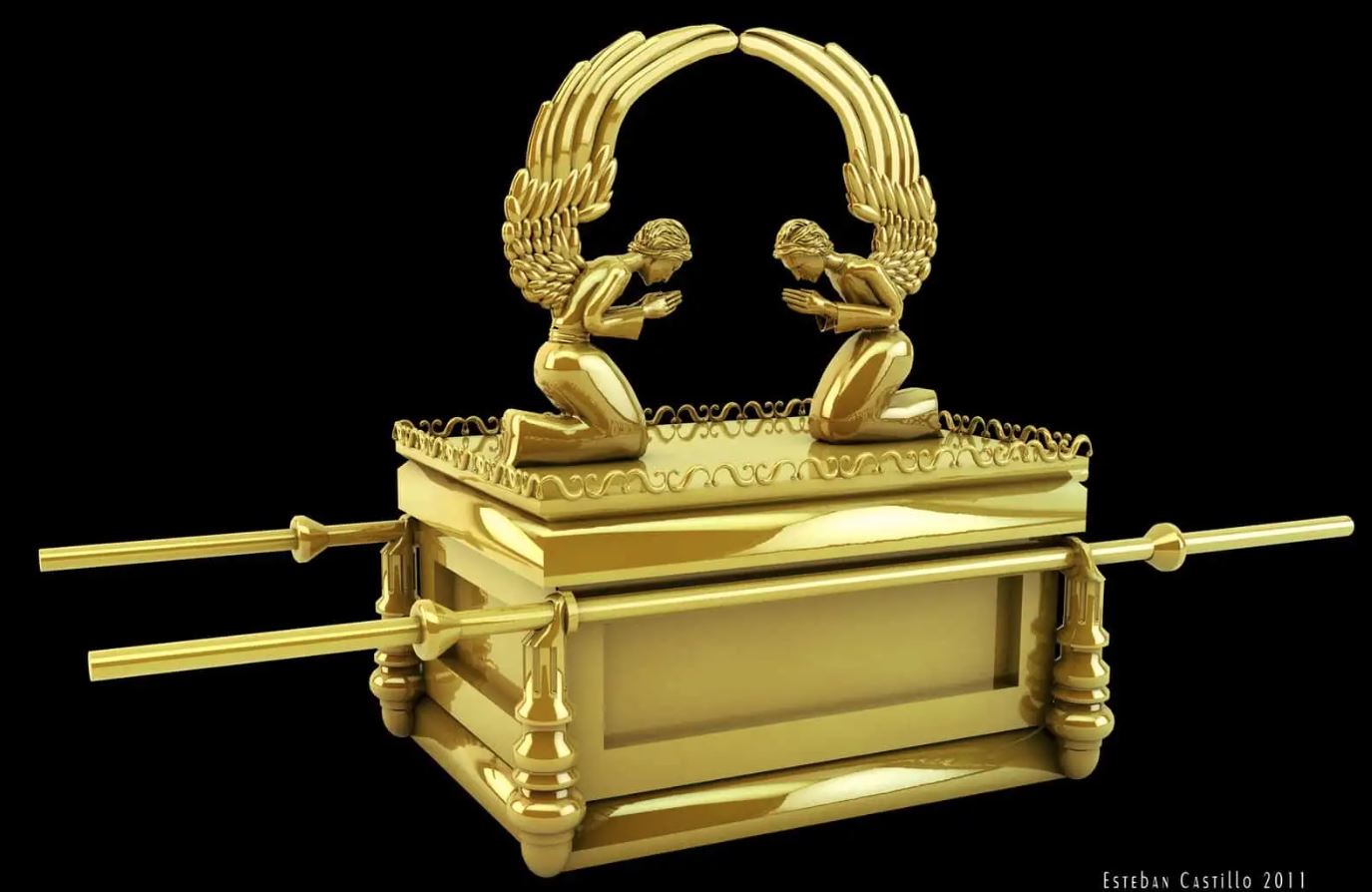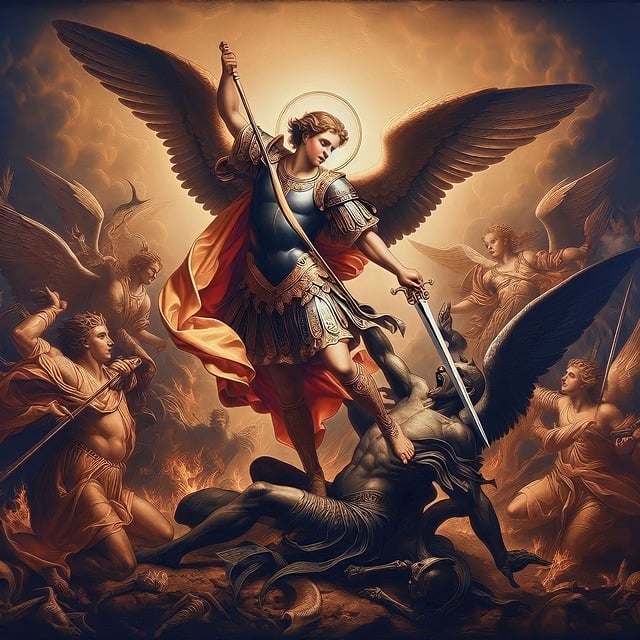The Ark of the Covenant is an extremely important religious artifact in Judaism which was created in ancient times. The greatly revered Ark was commanded by God to Moses to create with very detailed instructions as given in the Biblical book of Exodus. This artifact is a gold plated, inside and outside, acacia wooden rectangular chest with art work designs that has two very long horizontal rods, that are acacia wood with gold overlay. attached to the chest on four gold rings for carrying. The Ark was heavy and the two beams were carried by multiple priests of the Levi tribe on their shoulders. While being carried, the Ark was not permitted to touch the ground. On top of the lid of the chest are two golden figurines of winged angels called “cherubims” facing each other from a short distance whose four very long wings shield their eyes and the ark below. The Ark of the Covenant is also known as the Ark of Testimony or as the Ark of God.
Inside the blessed Ark are, according to legends, various sacred religious and historical items of the Jews that include as follows: a golden jar containing manna: the bread from Heaven, Aaron’s rod which “magically” (miraculously) sprouted blossoms and almonds,and the tablets of the Covenant: the tablets of the law: the two stone tablets inscribed with the Ten Commandments that Moses had on him after he came down from Mount Sinai. The Ark of the Covenant and its possessions inside are very sacred to both Jews and Christians. There was a special blanket used to cover the Ark when not being used in religious activities.

At the top of the holy Ark was a place where a big bowl was seated ; inside the container was the blood from a ceremoniously murdered animal. Then the priest sprinkled the blood of the ritually sacrificed animal upon the chest lid; that has the two angels; the front part of the Ark. Such a sacrificed animal includes, but are not limited to a bull, a ram,sheep, a lamb, a goat, or a dove. The bloody offering was believed to produce a blessing from God to the nation of Israel and its Jewish people. The Ark of the Covenant was in the great temple synagogue in the capital city of Jerusalem.
Inside the Jewish temple, the sacred Ark was in a room in which there were curtains with gold linings at the edges; borders that covered the view. After many centuries, the curtains were taken away providing a clear view of the proceedings. The Great Jewish Temple was destroyed and looted of its sacred contents by the Romans in 70AD during the war between Rome and Judea. Hundreds of thousands of Jews perished in the siege of Jerusalem and elsewhere in the country and many thousands more Jews were sold into slavery.
The Western Wall, also known as the “Wailing Wall” or the “Kotel” or “Kosel” is the last remaining outer wall of the ancient Jewish Temple. The Great Synagogue was actually the Second Temple of the Jews. The First Judaic Temple was built by King Solomon (circa 990 BC-931 BC) and in Jewish legend at the spot where, thousands of years before, God create the first man, Adam. But, the holy building was destroyed by fire four hundred years later in 586 BC by King Nebuchadnezzar of Babylon after his armies conquered Jerusalem. The Second Temple was built in 538 BC, after the Jews returned to Jerusalem from Babylon captivity under the military might of the Persian King, Cyrus the Great; who overthrew King Nebuchadnezzar; the Second Temple was constructed over the ruins of the First Temple. Zerubbabel, the Governor of Judah, ordered the re-building. Another re-building of the 2nd Temple occurred under King Herod the Great (37 BC to 4 AD) of Judea. The work began in 20 BC and lasted for 46 years. The perimeter of the Temple Mount was doubled and encased by a retaining wall with gates. The Jewish Temple was then raised , enlarged, and coated with white paint.
The Ark of the Covenant and its precious cargo, seems greatly to have simply vanished over the last few thousands years. Basically, the beloved Jewish relic seems to have become unaccounted for during or before the Babylonians sacked the Temple of Jerusalem in 586 BC. Some historical scholars believe the Ark and its contents were destroyed then by the military Babylonians, but there is no proof of this occurrence. The Roman armies in 70 AD could have destroyed the Ark and its contents, but there is no proof they did so. In folklore, over the centuries, there are stories that the Ark was brought out the Holy Land by the Christian Crusaders and taken to Europe, going through various countries in cathedrals but then becoming untraceable to hide it. Other tales have the sacred structure going out of the Holy Land and into various nations in Africa, among first Jewish communities, then centuries later, Christian communities and disappearing while being hidden away in ancient churches or within special property away from the churches, but own by the churches.

The Church of Our Lady Mary of Zion is an Ethiopian Orthodox Tewahedo Church, in the holy Christian city of Aksum, that claims to house the Ark of the Covenant, but there is no real proof of such a thing. In 1941, a professor of African and Oriental Studies (SOAS), at the University of London, England and the United Kingdom, Professor Edward Ullendorff, claimed to have examined the Ark of the Covenant of that Orthodox Tewahedo Ethiopian Church and then pronounced the relic to be “a middle to late medieval construction” which means that Ark of the Covenant is just a model, centuries and centuries old, and not the original, ancient sacred relic. Professor Edward Ullendorff died in 2011. For many years now, the so-called Ark of the Covenant in fore mentioned church is no longer made available for examination by archeologists and scientists.
For centuries, that particular church has claimed to have the actual Jewish Ark. Not even the high priest of Aksum can enter the secure protective, secret site. Its only custodian is a virgin monk who cannot leave the sacred grounds until his death. African religious tradition is that the Queen of Sheba brought the Ark from Jerusalem to Africa in ancient times among the Jewish population there. Then the Ark was placed in various secret hideaways over the many centuries. But, there is no type of archeological proof to that belief.
For many centuries, there have been individuals who believed the Ark of the Covenant to be some sort of repository for having magical powers. Many people even today still hold such an opinion. In the Old Testament Bible, there are stories of Moses and others hearing the voice of God from the area on the Ark of where a slaughtered animal was made. At certain times in ancient times, there was a belief that the sacred relic would act as some sort of protective talisman for the whole tribe of Israel from being defeated in battle against the army of an enemy people. But, at times, the Ark has been known to fail in providing such protection, as mentioned in stories in the Old Testament Bible. There is also the belief that to touch the Ark is cause God to very quickly strike down that person down with death, which is in violation of divine law, based on the Biblical story of the death of Uzzah, who steadied the Ark with his hand, and then immediately died.
Does the Ark of the Covenant and its contents still exist? Has the holy artifact with its accessories been destroyed? Who really knows. Most archeologists doubt the Ark of the Covenant will ever be found.



